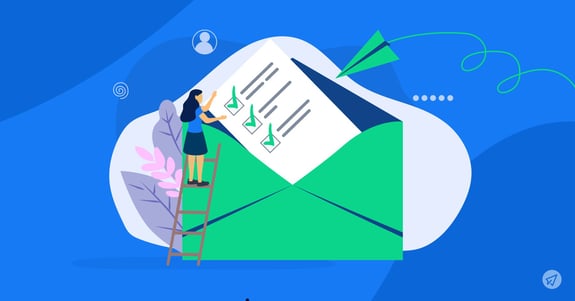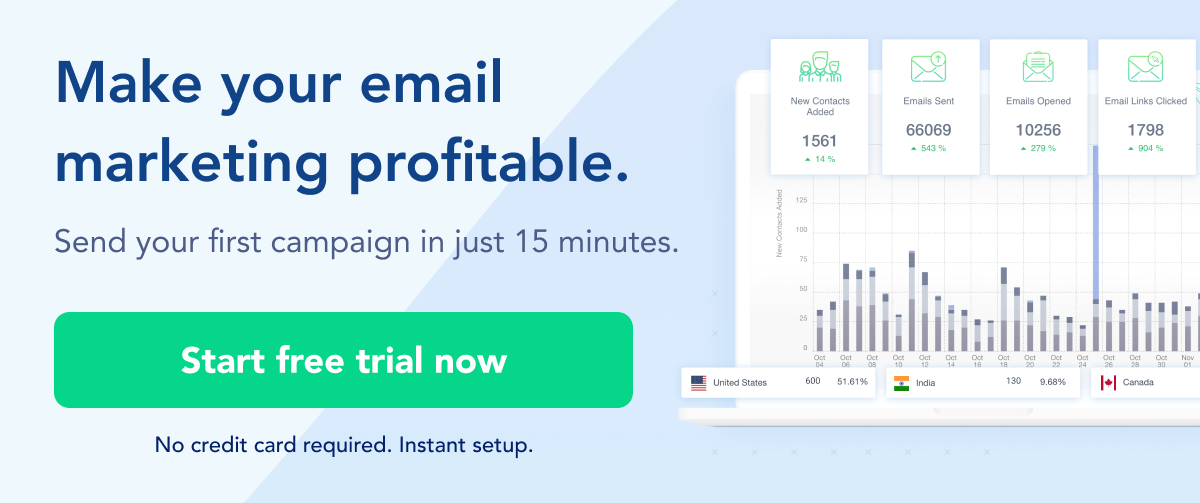Have you noticed a drop in engagement from your email subscribers recently? If so, then my friend you need to start writing winback emails!
Winback emails present a tremendous opportunity to re-activate disengaged subscribers and encourage renewed participation.
Also known as re-engagement or trigger emails, strategically crafted winback messages inspire inactive subscribers to reconnect with your brand, often leading to increased sales.
In this post, we’ll explore how to leverage segmentation, personalization, compelling offers, and multi-channel coordination in your winback email approach. Let’s go!
Table of Contents
- It All Starts with Understanding Your Audience
- Take the Time to Craft a Compelling Subject Line
- Personalized Content for the Win(back)!
- Create a Sense of Urgency
- Don’t Forget to Reinforce Your Value Proposition
- A Quick Word on CTA Optimization
- Consider Timing and Frequency
- 4 Examples of Great Winback Emails
It All Starts with Understanding Your Audience
Connecting with the right subscribers is key for winback email success. Start by analyzing your data to identify customers who have gone inactive. Use email analytics tools and segment subscribers based on drop-off dates, last-click actions, or decreasing engagement over time.
Look for trends in disengaged segments as clues to inform your messaging. Did they previously purchase certain products, read specific content, or click on certain links? Tailor the tone and your marketing offers to re-spark their initial interest.
Additionally, leverage subscriber preferences and purchase history insights to personalize content. Remind them of items they bought or liked. Feature complementary products or upgrades. Show you understand their needs and are ready to deliver more of what they want.
Getting winback email targeting right is all about precision. Zone in on subscriber segments that present the highest win-back value based on recency, frequency, and past spending habits. Design focused content that speaks to their demonstrated interests and preferences for optimal relevance.
Take the Time to Craft a Compelling Subject Line
The subject line can make or break your winback email's success. With inboxes flooded daily, an intriguing and personalized subject piques subscriber curiosity to open.
The best winback email examples have subject lines under 50 characters that feature the subscriber’s name and convey the value incentive.
For example, “John, here’s 30% off your next order” is specific and benefit-driven.
Use dynamic fields to incorporate names, past purchases, interests, or trigger data like abandoned cart items.
Pro Tip: Subject line A/B testing fine-tunes performance over time.
For instance, compare “We miss you, Sarah!” to “Come back for 50% off, Sarah!” to see which generates more opens. Or you can test offering dollar discounts vs. percentage-offs.
Pay attention to open rate lift among disengaged segments to double down on top performers.
Keep a swipe file of subject line ideas that highlight subscriber exclusivity. Things like “Special coupon just for you” or “VIP deal inside!” build anticipation. Add urgency like “24-hour flash sale!” to incentivize quicker action. Maintain an ongoing testing mindset, being willing to pivot creative or offers that don’t resonate.
Personalized Content for the Win(back)!
Winback email content should feel like it was written just for the subscriber. Leverage data and segmentation to understand potential disengagement drivers. Did they receive overly promotional messaging? Feel overwhelmed by email frequency? Did they not find value in recent content?
Address friction points head on in your copy. If someone showed preferences for DIY tips but got blanket promotions, recap relevant DIY articles as a peace offering. Give them specific reasons to re-engage based on demonstrated interests.
Dynamic content personalization takes this further. Include past purchase details, identified preferences, recent site browsing, or trigger data like abandoned cart items in the copy. Recommend complementary or higher-end product alternatives tied to their unique history.
Personalized content demonstrates you value the individual. Avoid one-size-fits-all offers and dial up the customization. Prove you want to reconnect on their terms.
Create a Sense of Urgency
Urgency transforms engagement from “I'll think about it” to “I better act now!” After periods of inactivity, subscribers need compelling reasons to return. Think limited-time promotions, flash sales and expiring coupons. These all convey time sensitivity. But don’t get too spammy with it!
For example, instead of a generic 10% off offer, create exclusive 72-hour cyber flash deals for reactivated subscribers. Countdown timers heighten the ticking clock pressure, encouraging impulse purchases.
Or surprise them with unexpected free gifts like free shipping or bundled bonus items that disappear in coming days.
Another tactic is gating - withholding access to something desirable until the subscriber takes an action. For instance, present an eBook, checklist or video subscribers previously shown interest in, but require a form fill or purchase to access it now.
Scarcity spurs desire and separates window shoppers from re-activated buyers.
Balance urgency with real value rather than empty hype about fake deadlines. Find ways to incentivize faster decisions uniquely for disengaged subscribers through discounts and perks that meaningfully move the needle.
Don’t Forget to Reinforce Your Value Proposition
Winback emails represent the perfect opportunity to re-communicate your core value proposition. Remind disengaged subscribers exactly why they signed up.
Boldly state key differentiators that can re-spark interest (i.e. quality, price, speed, customer service or selection).
Feature highly-rated products the subscriber purchased previously as cues to repurchase. Highlight any new offerings, features or improvements made since their last visit.
For example, an online clothing boutique could showcase the latest on-trend styles at competitive pricing. Or a cooking retailer might share new chef-curated recipes and hard-to-find ingredients.
Use value reinforcement messaging to address reasons for subscriber drop off too. If someone complained of limited payment options, announce newly added Apple Pay and Affirm checkout. If customers requested faster shipping, proudly feature the just-launched 2-day delivery promise.
Close the value loop by showcasing happy customer testimonials, awards won, or press features that lend third-party credibility. Remind subscribers why they originally connected with you, then give them exciting reasons to re-engage.
A Quick Word on CTA Optimization
Compelling winback content means little without clear calls-to-action (CTAs) driving re-engagement. Strategically pepper CTAs throughout emails, not just at the bottom.
Craft goal-specific CTAs tied to metrics like reactivating purchases, encouraging referrals or prompting product reviews. Use action-driving language like “Buy Now” instead of vague phrasing like “Learn More.”
Format CTAs as eye-catching buttons in complementary colors. Repeat the CTA text in the button to beat banner blindness. Ensure buttons stand out with things like sufficient padding, large 14 pt text, and prominent placement.
Test CTAs for impact by placing them inline with content vs. the footer. Try adding exit intent pop-up CTAs as they’re leaving if commerce metrics lag. Observe subscriber behavior to eliminate unclear navigation or page flow friction upon return.
The ultimate winback CTA benchmark: spurring reactivations and renewed transactions. Allow form fills, content downloads or social shares as interim ‘baby step’ conversions before quantifying email ROI with revenue metrics. Keep iterating and A/B testing CTAs until you drive re-engagement wins.
Pro Tip: Use a Multi-Channel Approach
Don’t just use emails to try and win people back. Integrating winback emails with other marketing channels such as Facebook and Instagram creates a more cohesive and impactful winback strategy.
For example, your coordinated efforts could look like this:
Subscriber hasn’t opened an email in a while. Using the Facebook pixel, you send targeted ads to current people on your email list. They now see you in their inbox, and in their social media feed. This makes them more likely to click the next email they receive from you.
Note, this strategy doesn’t always work. However, when you use the same messaging in social media marketing as well as your email marketing, it can help to get in front of your target audience.
Consider Timing and Frequency
Successfully re-engaging dormant subscribers requires sending winback emails at the optimal moments. Analyze historical purchase cycles and site activity by segment to identify ideal timing.
For example, lapsed customers may be more responsive on the anniversary of original sign-ups or first purchases. Or target weekend dead time for impulse shoppers.
Test timing by day-of-week as well. Some sources believe that the best day to send winback emails is on Tuesdays. However, you might find that for your audience Fridays are best. Audit high-level audience behaviors to pinpoint responsive timing patterns.
Likewise, avoid sending too frequently without enough value variability. Space out messages and rotate offers so each feels fresh, not fatiguing. Welcome winbacks first via email or popup. Then follow up with incentives via cart abandonment flows or SMS sequences.
4 Examples of Great Winback Emails
To close things out, here are some examples of great winback emails from my own inbox:
1. Ibotta
What they did right:
They offered a $5 gift of free money to come back to the platform. And, they had a deadline to redeem the offer!
2. EveryPlate
What they did right:
After canceling my account, they sent me an email reminding me that I have free boxes I can give to friends. This compels me to not only drive new sign ups to them, but gives me fear of missing out on the opportunity to sign up for the same meals my friends are going to get for free. And, they said my free boxes will expire making me want to act fast.
3. Macy’s
What they did right:
First, they offered me an extra 30% off. Second, they told me my offer ends tomorrow! And, they used an image that was bright and captured my attention in the body of the email.
4. AMC Movie Theaters
What they did right:
Again, they gave me a deadline. They also gave me a chance to double my points. This can mean getting free movie tickets much faster!
Hopefully these tips and examples will inspire you with how to improve your own winback emails!



